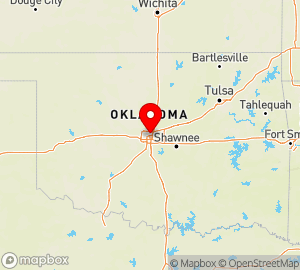Oklahoma
Oklahoma State Information

www.ok.gov
Area (sq mi):: 69898.19 (land 68667.06; water 1231.13) Population per square mile: 51.70
Population 2005: 3,547,884 State rank: 0 Population change: 2000-20005 2.80%; 1990-2000 9.70% Population 2000: 3,450,654 (White 74.10%; Black or African American 7.60%; Hispanic or Latino 5.20%; Asian 1.40%; Other 14.90%). Foreign born: 3.80%. Median age: 35.50
Income 2000: per capita $17,646; median household $33,400; Population below poverty level: 14.70% Personal per capita income (2000-2003): $24,407-$26,719
Unemployment (2004): 4.90% Unemployment change (from 2000): 1.80% Median travel time to work: 21.70 minutes Working outside county of residence: 23.80%
List of Oklahoma counties:
Oklahoma Parks
- US National Parks
- Urban Parks
- State Parks
- Parks and Conservation-Related Organizations - US
- National Wildlife Refuges
- National Scenic Byways
- National Grasslands
Oklahoma
Forty-sixth state; admitted on November 16, 1907
Since 1921, November 16 has been designated Oklahoma Statehood Day. It has also been Oklahoma State Flag Day since 1968. In 1957, in honor of the 50th anniversary of statehood, the state legislature decreed the week of November 1116 to be Oklahoma Week. In 1965, the lawmakers mandated public schools to conduct programs on the state’s history and achievements on November 16. Annual observance of Oklahoma Statehood Day began in 1921 under the sponsorship of the Oklahoma Heritage Association, which continues to hold a dinner at the state capital at which notable Oklahomans are inducted into the Oklahoma Hall of Fame. Oklahoma Statehood Day is also observed annually with a ceremony at the Washington Cathedral in the nation’s capital.
SEE ALSO OKLAHOMA DAY
State capital: Oklahoma City Nickname: The Sooner State State motto: Labor omnia vincit (Latin “Labor conquers all
things”) State animal: American buffalo (Bison bison) State amphibian: Bullfrog (Rana catesbeiana) State beverage: Milk State bird: Scissor-tailed flycatcher (Muscivora forficatus) State butterfly: Black swallowtail (Papilio polyxenes) State cartoon character: Gusty State children’s song: “Oklahoma, My Native Land” State colors: Green and white State country and western song: “Faded Love” State crystal: Hourglass Selenite Crystal State fish: White (sand) bass (Morone chrysops) State floral emblem: Mistletoe (Phoradendron serotinum) State flower: Oklahoma Rose; wildflower: Indian blanket
(Gaillardia pulchella) State flying mammal: Mexican free-tailed bat State folk dance: Square dance State fossil: Saurophaganax Maximus State fruit: Strawberry State furbearer: Raccoon State game animal: White-tailed deer State game bird: Wild turkey State grass: Indiangrass (Sorghastrum nutans) State insect: Honeybee (Apis mellifera) State meal: Fried Okra, Squash, Cornbread, Barbeque Pork,
Biscuits, Sausage & Gravy, Grits, Corn, Strawberries,
Chicken Fried Steak, Black-eyed Peas, and Pecan Pie State monument: The Golden Driller State musical instrument: Fiddle State percussive musical instrument: Drum State poem: “Howdy Folks” State reptile: Collared lizard (mountain boomer, Crotaphy
tus collaris) State rock: Barite rose (rose rock or Cherokee rose) State soil: Port Silt Loam (Cumulic haplustolls) State song: “Oklahoma!” State theater: Lynn Riggs Players of Oklahoma, Inc. State tree: Redbud (Cercis canadensis) State vegetable: Watermelon (Citrullus lanatus) State waltz: “Oklahoma Wind”
More about state symbols at:
www.okhistory.org/kids/aboutok.html
http://www.ok.gov/osfdocs/stinfo.html
SOURCES:
AmerBkDays-2000, p. 773 AnnivHol-2000, p. 192
CONTACT:
Oklahoma Heritage Association 201 NW 14th St Oklahoma City, 73103 888-501-2059 405-235-4458 www.oklahomaheritage.com/ oha@telepath.com
STATE OFFICES:
State web site: www.ok.gov
Office of the Governor State Capitol Rm 212 Oklahoma City, OK 73105 405-521-2342 fax: 405-521-3353 www.governor.state.ok.us
Secretary of State 2300 N Lincoln Blvd Rm 101 Oklahoma City, OK 73105 405-521-3912 fax: 405-521-3771 www.sos.state.ok.us
Oklahoma Dept of Libraries 200 NE 18th St Oklahoma City, OK 73105 405-521-2502 fax: 405-525-7804 www.odl.state.ok.us
Legal Holidays:
| Day after Thanksgiving | Nov 25, 2011; Nov 23, 2012; Nov 29, 2013; Nov 28, 2014; Nov 27, 2015; Nov 25, 2016; Nov 24, 2017; Nov 23, 2018; Nov 29, 2019; Nov 27, 2020; Nov 26, 2021; Nov 25, 2022; Nov 24, 2023 |
Oklahoma
a state in the South Central USA. Area, 181,100 sq km. Population, 2,559,000 (1970), of which 68 percent is urban. The state capital is Oklahoma City, and Tulsa is the leading economic center.
Almost all of Oklahoma is a plain, with elevations of 200–500 m. The western part of the state is a plateau, with a maximum elevation of 1,516 m. The Ouachita Mountains, with elevations to 884 m, are located in the southeast. The climate is subtropical. Average January temperatures are 0°–6°C, and average July temperatures are 24°–27°C. Annual precipitation totals 450 mm in the west and 1,000 mm in the east. The main rivers are the Arkansas and the Red, tributaries of the Mississippi. Much of the land is cultivated; broad-leaved forests are still found in the mountains.
In terms of output value, Oklahoma is the fourth largest mineral-producing state. The principal products are oil (30 million tons in 1970, fourth place in the USA), natural gas (43 billion cu m in 1969, third place in the USA), zinc, and coal. Manufacturing employed 135,000 people in 1970. Machine building and metalworking, including the manufacture of parts for aircraft and tractor trucks, are important. The state produces mining and construction equipment and metal structural members. It also has oil refining, production of chemicals, flour milling, and meat-packing. The electric power output was more than 20 billion kW-hr in 1969.
Animal husbandry, especially meat production and dairying, is the leading branch of agriculture in terms of output value. With a 2,668,000-ton harvest in 1970, Oklahoma is a major US wheat producer. Large areas in the south are planted in cotton, and other crops include hay, peanuts, and grain sorghum.
M. E. POLOVITSKAIA